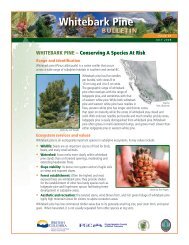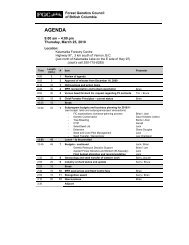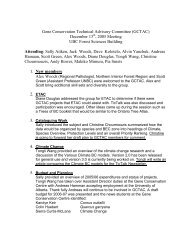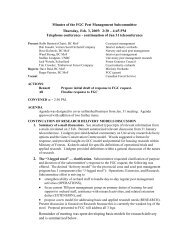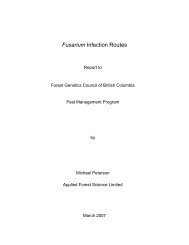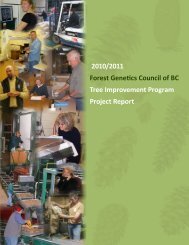Tree Improvement Program Project Report 2006 / 2007
Tree Improvement Program Project Report 2006 / 2007
Tree Improvement Program Project Report 2006 / 2007
You also want an ePaper? Increase the reach of your titles
YUMPU automatically turns print PDFs into web optimized ePapers that Google loves.
it must be noted that the genotypes that form females late<br />
may also be induced much later. In other words, there is a<br />
delay in differentiation in some of the clones, which should<br />
be reflected in the management of induction treatments,<br />
such as pruning or hormone induction. It is likely that<br />
the timing difference in the initiation of female strobili<br />
varies between the five clones. Overall, they differ from<br />
each other from two to four weeks. Initiation of female<br />
(and lateral-shoot) buds would appear to be in mid-July.<br />
Female strobilus differentiation likely begins in late July for<br />
some genotypes because female buds could be observed by<br />
August 1, <strong>2006</strong>. Based on this observation, female strobilus<br />
initiation is more highly variable than was previously<br />
suspected. This means that induction treatments should be<br />
implemented in early July if they are to maximize female<br />
bud formation. We suggest that female strobilus induction<br />
treatments need to be carried out in a genotype-specific<br />
manner.<br />
The pattern of male differentiation among the clones<br />
selected for histological analysis showed that male initiation<br />
and differentiation occurred before the first date of longshoot<br />
bud collection, namely July 5, <strong>2006</strong> (Table 25). Male<br />
strobilus initiation occurred at some time in June <strong>2006</strong>.<br />
Due to the advanced stage of development of male<br />
strobili observed for some of the clones, it is likely<br />
that initiation occurred even earlier. Male strobilus<br />
differentiation is also thought to occur earlier than<br />
previously published (Owens <strong>2006</strong>).<br />
Induction strategies of female buds of lodgepole pine<br />
should take into account the information summarized<br />
in Figure 74. Within long-shoot buds there is a marked<br />
apical-basal gradient: typically, the bottom half developed<br />
male and short-shoot buds, whereas the top half has either<br />
short-shoot buds and later female buds and lateral-shoot<br />
buds. Within each half there are also gradients, with males<br />
mostly formed at the bottom of the bottom half. In the<br />
upper portion, female buds and lateral-shoot buds are the<br />
latest to form, but female buds are almost always higher up<br />
the distal portion than lateral-shoot buds. A time factor also<br />
comes into play because buds form in an obvious order:<br />
males precede short-shoot buds and lateral-shoot buds,<br />
and female buds are last. This means that induction of<br />
female buds can occur after male buds have visibly formed<br />
(as observed under a dissecting scope), but not long after<br />
because the period from short-shoot bud initiation to<br />
female bud initiation is no longer than three weeks.<br />
A practical conclusion of this work is that when<br />
males are readily apparent in halved long-shoot buds<br />
T R E E I M P R O V E M E N T P R O G R A M<br />
P R O J E C T R E P O R T 2 0 0 6 / 2 0 0 7<br />
(longitudinally bisected leader shoot tips), it is time<br />
to apply induction treatments to optimize female bud<br />
initiation.<br />
Acknowledgments<br />
We gratefully acknowledge the assistance of Dr. Mike<br />
Carlson and Chris Walsh of KRS in providing us with plant<br />
material and much advice. We also appreciate the work of<br />
Heather Anholt, who collected samples for us.<br />
References<br />
Anonymous. Ministry of Forests and Range. Available from<br />
www.for.gov.bc.ca/hfp/mountain_pine_beetle/ [accessed<br />
November 15, <strong>2006</strong>]<br />
Bonnet-Masimbert, M and Webber, JE. 1995. From flower<br />
induction to seed production in forest tree orchards. <strong>Tree</strong><br />
Physiol. 15(7-8): 419-426.<br />
Greenwood, M. 1980. Reproductive development in<br />
loblolly pine. 1. The early development of male and<br />
female strobili in relation to the long shoot growth<br />
behavior. Am. J. Bot. 67(10): 1414-1422.<br />
Gutmann, M. 1995. Improved staining procedures for<br />
photographic documentation of phenolic deposits in<br />
semi thin sections of plant tissue. Journal of Microscopy<br />
179: 277-281.<br />
Gutmann, M, von Aderkas, P, Label, P, and Lelu, M. 1996.<br />
Effects of abscisic acid on somatic embryo maturation of<br />
hybrid larch. J. Exp. Bot. 47(305): 1905-1917.<br />
O’Reilly, C. J. 1986. Phenology and development of<br />
vegetative and reproductive structures in provenances of<br />
lodgepole pine. PhD thesis, Department of Biology, The<br />
University of Victoria, Victoria, BC.<br />
Owens, J. N. <strong>2006</strong>. The reproductive biology of Lodgepole<br />
Pine. FGC Extension Note 07. Available from http://<br />
www.fgcouncil.bc.ca.<br />
Rehfeldt, G. 1999. Genetic responses to climate in<br />
Pinus contorta: Niche breadth, climate change, and<br />
reforestation. Ecol. Monogr. 69(3): 375-407.<br />
Ross, S and Pharis, R. 1987. Control of sex expression in<br />
conifers. Plant Growth Regulation. 6(1-2): 37-60.<br />
69



